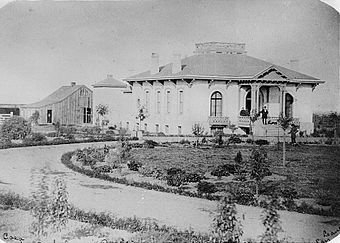Peralta Home facts for kids
|
Peralta Home
|
|

Peralta Home at time of construction, 1860
|
|
| Location | 561 Lafayette Ave., San Leandro, California |
|---|---|
| Built | 1860 |
| Architect | W.P. Toler |
| Architectural style | Spanish Colonial |
| NRHP reference No. | 78000654 |
Quick facts for kids Significant dates |
|
| Added to NRHP | November 22, 1978 |
The Peralta Home is a very old and special house in San Leandro, California. Located at 561 Lafayette Avenue, it was the first brick house ever built in Alameda County, California. This historic home was built in 1860.
It was designed in the Spanish Colonial style. The house was built for Ignacio Peralta, who was an early Spanish settler in San Leandro. His son-in-law, W.P. Toler, was the architect and builder.
A Historic Home in San Leandro
The Peralta Home is important because of its age and unique design. It stands out as one of the most interesting houses from the 1800s in San Leandro. The house also has strong connections to the large and powerful Peralta family.
Who Lived Here?
The Peralta family were pioneers in the area. Ignacio Peralta's father, Luís María Peralta, received a huge land grant. This grant was called Rancho San Antonio. The Spanish Governor Don Pablo Vicente de Solá gave him this land on October 20, 1820.
Changes Over Time
After Ignacio Peralta passed away, his widow, Rafaela Sanchez Peralta, sold the house. A.C. Peachey bought the home on May 18, 1875. Soon after, Peachey added a large wooden section to the back of the brick house.
The original Peralta house had its main living rooms on the second floor. Peachey kept this idea in his new additions. He used the ground floor mostly like a basement.
The house stayed with the Peachey family for 34 years. Later, between 1909 and 1926, Daniel and C.L. Best owned it. In November 1926, the Alta Mira Club purchased the house. They are still the owners today.
A Special Landmark
The Peralta Home is recognized as a very important historical site. It is a California Historical Landmark. It is also listed on the National Register of Historic Places. This means it is a nationally recognized historic building.
![]() This article incorporates public domain material from websites or documents of the National Park Service.
This article incorporates public domain material from websites or documents of the National Park Service.


